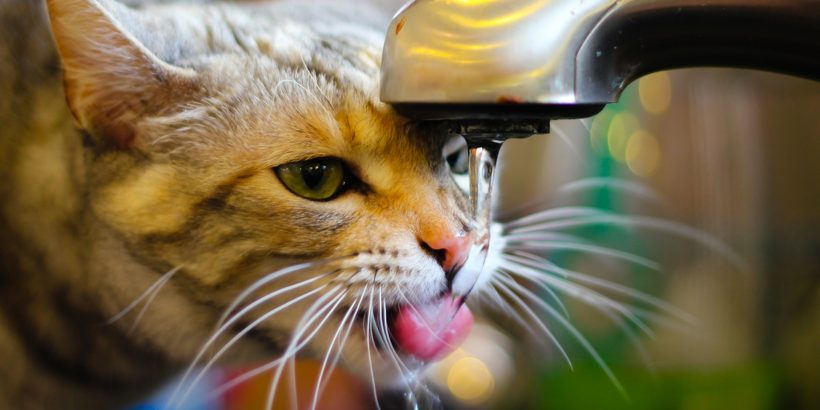Muddy puddles, a slimy water bowl, or an open toilet are no deterrents to a thirsty dog. Cats, however, are very particular about their water sources. Their water dish may remain untouched, but the moment they hear a running faucet they magically appear. In this article, we will discuss ways to get our favorite felines to drink more liquids, understand cats’ drinking quirks, and learn the signs of dehydration.
What Cat’s Need: According to Dr. Lynn Wilson, a Volusia County-based veterinarian with over 20 years of experience, most cats do not get enough water in their diets. ”An average healthy 10 lb. cat needs at least 15 tablespoons of water a day to maintain healthy hydration, and many are not reaching this goal,” she explains.
Problems caused by lack of sufficient water: Insufficient water in your cat’s diet causes dehydration, which makes cats susceptible to many painful and sometimes fatal urinary tract and bladder inflammation and infections, cystitis, feline urinary tract disease (FLUTD) and the formation of life-threatening kidney stones. These damage the kidneys and can lead to kidney failure, the most common and preventable cause of illness and death in cats over 5 years of age. Kidney disease can also contribute to cardiovascular failure in cats.
Recognizing the signs of dehydration: It is important for pet owners to recognize the signs of dehydration in their cats. These include listlessness, refusing to eat, sunken eyes, panting and dry and sticky gums. A good way to test your cat for dehydration is “skin tenting.” Take a pinch of skin around your cat’s shoulders and gently pull it up. The skin should immediately fall right back into place. If it falls back more slowly, this is an indication of dehydration. If it remains tented, this is a sign of a dangerous level of dehydration and your cat needs immediate veterinary attention.
Recognizing the signs of bladder and urinary tract infections: Cats (both male and female) are prone to a variety of bladder and urinary tract infections. Some of these are serious and life-threatening and you should take your cat to the vet immediately if you notice any of these signs:
- Frequent trips to the cat box, with only a small amount ofurine being passed
- Straining and/or crying out while urinating
- Blood in the urine
- Urinating outside of the litter box, especially on cool surfaces that feel soothing to a cat in pain, such as tile, a sink or the bathtub.
- Excessive licking of the abdomen or genitals
Cats need wet food: The best way to ensure your cat is getting enough water in his diet is by feeding him some canned wet food every day (with a few tablespoons of water added). Eating wet food gives your cat nutrition while keeping him hydrated. As Dr. Wilson mentions, “In our practice, we believe that wet food in the diet gives cats the best chance to attain a healthy 15 to 20 year life-span.”
- Dry Vs. Wet food: Dry cat food is at most 10% water and provides approximately half a tablespoon of water, whereas wet food is approximately 78% water and provides 6 to 9 tablespoons of water.
- Low thirst drive: Cats have a low thirst drive in comparison to humans and dogs and most do not drink enough water on their own, which can lead to many health issues. Cats are carnivores and undomesticated cats get their daily liquid requirements from their prey. Our pet cats depend on what we feed them, so wet food daily is a must.
- Add water to the wet food: When feeding your cat either wet food only or a wet/dry mix, always add 3 or more tablespoons of water or other clear liquids for additional moisture content (add one tablespoon at first, increasing it every few weeks).
- Other clear liquids: Can include the fluids from cans of tuna, salmon, mackerel, or clam juice.
- Our recommendation: Leave dry food out for your cat if this is your normal routine, but feed him at least half of a 5.5 ounce can of wet food with 1-2 tablespoons of water added to it every night. Better yet, give him wet food twice a day with the additional water added.
- Click here, for more information on why wet food is so important, the price involved, or to learn tricks if your cat doesn’t like wet food.
CAT QUIRKS ASSOCIATED WITH WATER DISHES:
- Fresh water: Make sure you refill your cat’s water dish every day with fresh water as it could taste stale to your cat otherwise. Make sure the bowl is washed and kept clean.
- Filled to the brim: Be sure to keep his water dish filled to the brim. Cats have sensitive whiskers and many cats will not dip their heads down into a dish for water as they do not like their whiskers hitting the edges of the bowl. Also, cats’ eyes cannot focus on anything closer than 4 inches and they rely on their senses of smell and touch. Since they can’t smell the water or feel it at the top of the dish, they simply don’t know it’s there, so keep those water dishes fresh and full!
- Get rid of plastic dishes: If you’re using a plastic water dish, you might consider switching to glass, ceramic or stainless steel. Plastic dishes cannot be fully cleaned as bacteria can live within tiny scratches on the surface, which may result in a smell that repels your cat from drinking. These dishes may also cause cat acne.
- Multiple water sources: Place water dishes in several areas of the home. Some cats won’t touch water if it’s too close to their food bowl so make sure to place one in a different location your cat likes to hang out at.
- Switch to filtered water: If you know your area has hard water or water with a strong chemical or chlorine smell, you may want to switch to filtered water for your cat. Cats are very sensitive to tastes and smells that you may not notice and a chemical or chlorine smell might keep your cat from drinking as much as he wants to. There are many inexpensive water filters that attach right to your kitchen faucet and ensure healthier, purer water for not just your cat, but your whole family!
CATS LOVE FLOWING WATER!
- Water Fountains: Investing in a pet water fountain is a great choice. Cats are naturally drawn to running water because they can see it moving. Water in a fountain is constantly being pumped through a filter which causes it to be oxygenated. This means your cat’s water is cooler and tastes fresher and is more enticing.
- Straight from the tap! Many cats love to drink water right from the tap. Run a thin stream from your kitchen or bathroom sink for a few minutes throughout the day, if your cat seems to enjoy this.
OTHER LIQUIDS CATS LOVE:
- Milk made for cats: Most cats are lactose-intolerant and should never be given cow’s milk. However, there are many lactose-free milk products available in pet stores designed specifically for cats that provide the creamy taste that cats love and that add needed liquid to their diets.
- Baby Food – Meat Only: Try a baby food treat! Mix a teaspoon of meat-only baby food with up to 1/4 cup of water. Warm water will enhance the flavor. (Baby food is not a balanced diet for a cat and should not exceed 10% of the total daily food intake).
- Add other flavors: Add a drop or two of tuna, sardine, mackerel, or clam juice to the 3 or more tablespoons of water. The juice can just be drained out of the cans and plain clam juice is sold in most supermarkets. Be sure to also have a dish of fresh plain water available at all times.
IN SUMMARY: You simply cannot rely on your cat to drink enough water on his own and when a cat becomes dehydrated it can cause kidney failure, the leading cause of death in cats over 5 years old. Luckily, there are important steps you can take to protect your cat by adjusting its diet, adding extra water to the wet food and giving alternative fluids to help hydrate your cat for a long and healthy life. Your cat may not know how much water he needs to stay healthy, but now that you do, we hope you will make this change.

